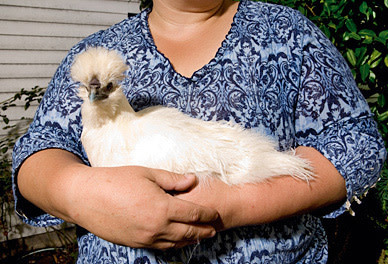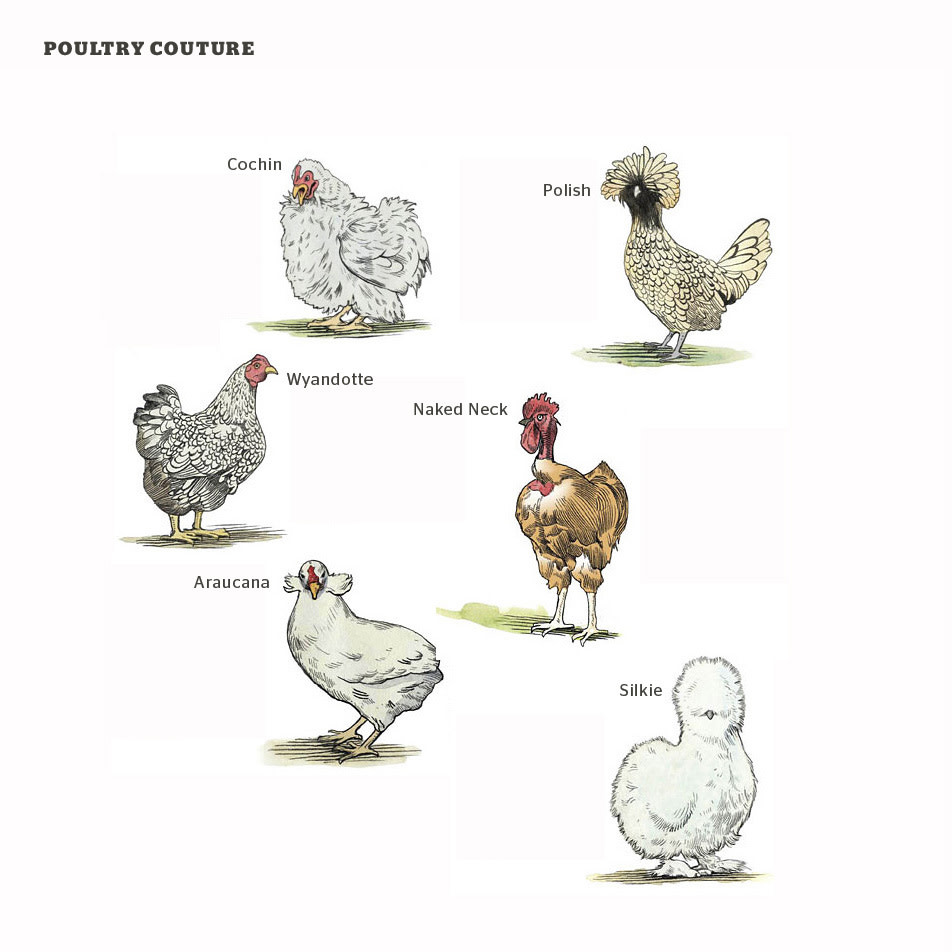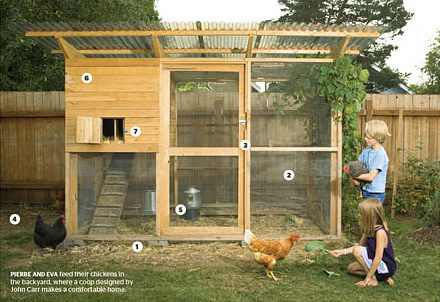Belles of the Backyard

Fingerlickin’, fried, and roasted are the quickest words off the tongue when it comes to chicken. But if you’re going to raise the birds yourself, consider adopting the vocabulary of couture over that of the kitchen. How better to describe the perky, iridescent headdresses; the frothy white skirts; and the lacy, veiled coverlets of the many barnyard beauties who can bring surprising elegance, endless entertainment, and, of course, a steady supply of delicious eggs to your backyard?
{page break}
Sure, the standard Rhode Island Red bought at a farm supply store will deliver a satisfying 300 eggs a year. But fetching eggs for the morning scramble from your Ziggy Stardust-esque blue Silkie certainly adds a little glam to your routine. And just imagine being entertained by your golden Polish with her haute headdress as she struts and poses, performing her daily défilé in your garden.
Chickens live 5 to 10 years, quickly growing from adorable puffs of fluff into egg-laying dynamos in about 16 weeks. A good egg-layer will turn out between 150 and 250 eggs annually before petering out around age 3. In Portland, keeping up to three hens in your yard is allowed. Roosters, which are not required for egg production, only fertilization, are prohibited because of their loud crowing and occasionally aggressive temperaments. Contact the Multnomah County Health Department (503-988-3464) for more details on rules and regulations.
Buying a pullet (a full-grown hen under age 1) near laying age is certainly an easy option. But raising baby chicks can trigger floods of parental pride when your little one lays her first egg. Obtaining young chickens is recommended if mixing breeds; otherwise you’ll quickly learn the origins of the phrase “pecking order.” Local farm and feed stores offer baby chicks for sale each spring, but usually only limited varieties are available. Finding more dazzling breeds to raise will take a little more effort. Pistils Nursery (3811 N Mississippi Ave) also sells chicks in the spring and will order in specific breeds if requested. Mail-order hatcheries will send day-olds through the US mail with excellent results, but they sometimes require minimum orders (see “Chicks ’n’ Stuff,” below, for hatcheries and suppliers).
{page break}
Types of Chickens

Silkie
Calm + Pretty
A Hollywood starlet’s powder puff come to life, the Silkie is characterized by its unique, fluffy plumage. With blackish skin and bones—and five toes rather than the usual four—this bantam is one of the more unusual breeds in the farmyarm.
EGG PRODUCTION: Fair layer of small, lightly tinted eggs.
AS PETS: Very docile
AS MOTHERS: Exceptionally broody
PLACE OF ORIGIN China/Southeast Asia
EXOTIC LEVEL: 8
Polish
Sexy
Like an avant-garde Oscar gown on chicken legs, the Polish is kept mostly for its exotic, ravishing locks. In addition of a comb, its head is adorned with a large, regal crest of feathers, due to a cone (called a protuberance) on the top of its skull.
EGG PRODUCTION: Poor
AS PETS: Can be bullied by others
AS MOTHERS: Not a good mother
PLACE OF ORIGIN: Europe (ironically, not Poland)
EXOTIC LEVEL: 9
Cochin
Nice Pet
The Cochin looks like it’s always wearing a long fir coat and is generally kept as an ornamental bird. Its defining characteristic is extravagant plumage, which cloaks its body, legs, and feet, exaggerating its already large size. For an even more extraordinary specimen, look for a Cochin Frizzle.
EGG PRODUCTION: Fairly poor; lays medium, yellowish-brown eggs.
AS PETS: Friendly
AS MOTHERS: Very broody, makes a good mother
PLACE OF ORIGIN: China
EXOTIC LEVEL: 8
{page break}

Naked Neck
Tough
The Naked Neck, with its eponymous exposed nape, may not be everyone’s cup of tea, but what it lacks in fluffy accoutrements it makes up for with a hear ability to withstand cold weather and illness.
EGG PRODUCTION: Good layer of light-brown, medium-sized eggs.
AS PETS: Very docile
AS MOTHERS: Ca be broody, makes a good mother
PLACE OF ORIGIN: Central Europe
EXOTIC LEVEL: 7
Wyandotte
Great Layer
A friendly, nonflighty bird, the Wyandotte also lays stunning eggs. It exhibits a distinctive lacy pattern on its feathers, and it comes in a rainbow of colors. A good Wyanotte will late more than 240 eggs a year.
EGG PRODUCTION: Very good, lays large, light- to rich-brown eggs
AS PETS: Usually docile, sometimes tends toward dominance over other birds
AS MOTHERS: Rarely broody
PLACE OF ORIGIN: Un
Araucana
Calm
Characteristically sideburn-like tufts on each ear and rumpless rears, these birds are most famous for their blue eggs. Sometimes called Easter egg chickens, Araucanas have become easily available largely thanks to Martha Stewart’s much-trumpeted fondness for her own brood.
EGG PRODUCTION: Good layer of green- to blue-colored, medium-size eggs
AS PETS: Calm, good with other types of chickens
AS MOTHERS: Moderately broody
PLACE OF ORIGIN: Chile
EXOTIC LEVEL: 5
{page break}
Raising Your Peeps
To get started, all you need is a draft- and predator-free place to nurture your chicks, like a basement or garage. Place a cardboard box on the floor and hang a height-adjustable 100-watt lamp with a downward-reflecting metal shade about 18 inches above it. Scatter a layer of wood shavings, sand, or shredded paper (avoid cedar chips—they can be toxic to baby chicks) in the box. Buy an inexpensive chick feeder and waterer at your local farm supply store.
Chicks are great at regulating themselves, eating and drinking only what they need. If they find their home too hot, they’ll avoid the bright light, or they’ll huddle together if it’s too cold. Adjust the light’s height as necessary. Replace the bedding when droppings begin to build up, and maintain a fresh supply of chick starter-food and water. During the first week, a temperature of 95 degrees is ideal. Each week thereafter, raise the bulb about 3 inches—which will lower the box’s temperature by about 5 degrees—until you’ve reached 70 degrees. This will condition the chicks for outdoor life.
After a few weeks your chicks will enter their awkward teen years. Parents can put away the camera as their chicks’ downy fluff goes a little punk—they’ll sport spiky young feathers and their necks, toes, and waddles will grow more quickly than their bodies. When their gorgeous, postpubescent, feathery coats finally blossom, they are ready to transition to grown-up food and the great outdoors.
Growing Up
Three grown chickens will eat about 50 pounds of food in 2 to 3 months. Feed your hens organic layer pellets, which are supplemented with calcium. Kitchen vegetable scraps also make excellent snacks—just take care to leave out the eggshells, as they may cause your chickens to start pecking at their own eggs in search of food.
At about 4 months, the adventure of egg-laying begins. It is not uncommon for
a young hen to be surprised by her first egg, and the first few might be misshapen or sporadically timed. Within a week or two she’ll hit her stride and enter full production mode. Expect fewer eggs in the winter, as day length regulates your chicken’s laying cycle.
Full-grown chickens require little other than clean, safe homes; food; and water. It is a rare bird that requires physical attention. Most prefer attention from afar. For a special treat, let your chickens roam freely in the yard.
{page break}

Coop Necessities
1. The coop and run are your chickens’ house and yard. They are also your chickens’ defense against predators—animals like raccoons, coyotes, hawks, rats, and foxes find chickens as tasty as many humans do. The run should be enclosed with wire mesh. It is important to bury the mesh in the ground to keep burrowing animals from digging under it.
2. The coop needs to have good ventilation, which helps prevent respiratory diseases while also protecting your chickens from the wind and the rain. Chickens can withstand cold temperatures, but they must be able to seek cover from a direct, cold wind.
3. The coop must be easy to clean so bugs and bacteria don’t accumulate.
4. The run should provide space. Ten square feet of roaming space per chicken is a good general rule, or half that for a bantam.
5. Provide a feeder and waterer. Hang the feeder about 6 inches off the ground to prevent the chickens from spreading food around the run.
6. Chickens like to roost—or perch—at night. Install roosting poles or elevated horizontal strips of wood for your chicken to sleep on. Place a removable tray under the roost to collect droppings and allow for easy cleanup.
7. Nest boxes should be approximately 1 square foot and filled with a soft material like wheat straw. This is where your hen will lay her eggs. These should be raised off the ground, but placed lower than the roosting poles. They also should be easily accessible from the outside for cleaning and egg-gathering.
{page break}
Chicks N’ Stuff
Mail-Order Hatcheries
Ideal Poultry Breeding Farms
254-697-6677
ideal-poultry.com
Pistils Nursery
3811 N Mississippi Ave
503-288-4889
pistilsnursery.com
Chicks sold March-June
Will take special requests for specific breed orders
Farm Supply Stores
Livingscape Nursery
3926 N Vancouver Ave
503-248-0104
livingscapenursery.com
Chicks, feed, waterers and feeders, heat lamps, books and resources
Concentrates
2613 SE Eighth Ave
503-234-7501
concentratesnw.com
Organic layer pellets, chick starter, and cracked corn milled in Oregon; bedding for both hens and chicks; pullet developer
Linnton Feed & Seed
10920 NW St. Helens Rd
503-286-1291
linntonfeed.com
Chicks sold March-May; chick starter, organic layer pellets, lamps, waterers
and feeders
Burns Feed Store
29215 SE Orient Dr, Gresham
503-663-3246
burnsfeed.hdweb.com
Chicks sold February-August; chick starter and supplies, waterers and feeders
Local Chicken Education
Growing Gardens
growing-gardens.org
Offers urban chicken-raising workshops; sponsors the annual Tour de Coops, a bike tour that showcases creative ways to house chickens in your backyard
